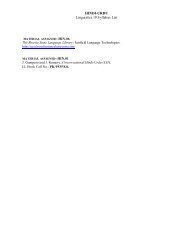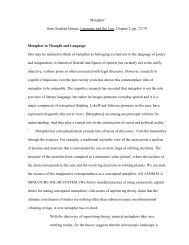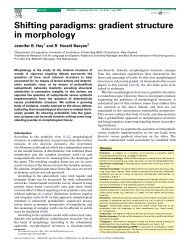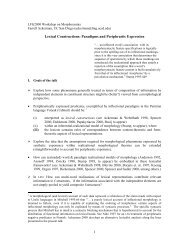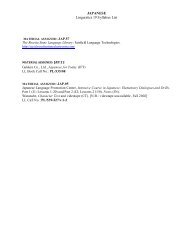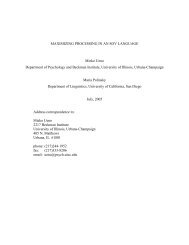Affricating ejective fricatives: The case of Tigrinya - Linguistics
Affricating ejective fricatives: The case of Tigrinya - Linguistics
Affricating ejective fricatives: The case of Tigrinya - Linguistics
You also want an ePaper? Increase the reach of your titles
YUMPU automatically turns print PDFs into web optimized ePapers that Google loves.
<strong>Affricating</strong> <strong>ejective</strong> <strong>fricatives</strong>: <strong>The</strong> <strong>case</strong> <strong>of</strong> <strong>Tigrinya</strong> 57Table 7 Results <strong>of</strong> linear mixed effects models with Speaker as random effect. <strong>The</strong> corpus contains <strong>ejective</strong> <strong>fricatives</strong> with no closure (NC)and pulmonic <strong>fricatives</strong>.Dependent variable nDF dDF F p(F) DirectionLaryngealized duration (log) 1 3 33.24∗/s’/ NC > /s/Amplitude slope 1 3 54.93∗∗/s’/ NC > /s/∗ = p < .05; ∗∗ = p < .01nDF = numerator degrees <strong>of</strong> freedom; dDF = denominator degrees <strong>of</strong> freedom; F = F-statistic; p(F) = probabilityTable 8 Counts <strong>of</strong> <strong>ejective</strong> and pulmonic <strong>fricatives</strong> with respect to closure.Pulmonic /s/ Ejective/s’/ TotalNo closure 278 66 344Closure 0 261 261Total 278 327 605Figure 8 Boxplots relating to the linear mixed effects models presented in Table 7.AffricateFricativeFigure 9 Boxplots pertaining to linear mixed effects models for <strong>fricatives</strong> without closure and affricates.<strong>of</strong> no-closure <strong>ejective</strong> <strong>fricatives</strong> was on average 38 ms greater than the release duration <strong>of</strong>affricates (for geminates) and 45 ms greater for singletons. Relevant boxplots are presented inFigure 9.3.3 Count data: Presence <strong>of</strong> closure and laryngealizationA Chi-square test was used to determine whether or not the proportions <strong>of</strong> pulmonic and<strong>ejective</strong> <strong>fricatives</strong> that manifested closure differed significantly. <strong>The</strong> results indicate that theydid: χ 2 (1, N = 605) = 569.15, p < .001. Counts for these variables are given in Table 8.




